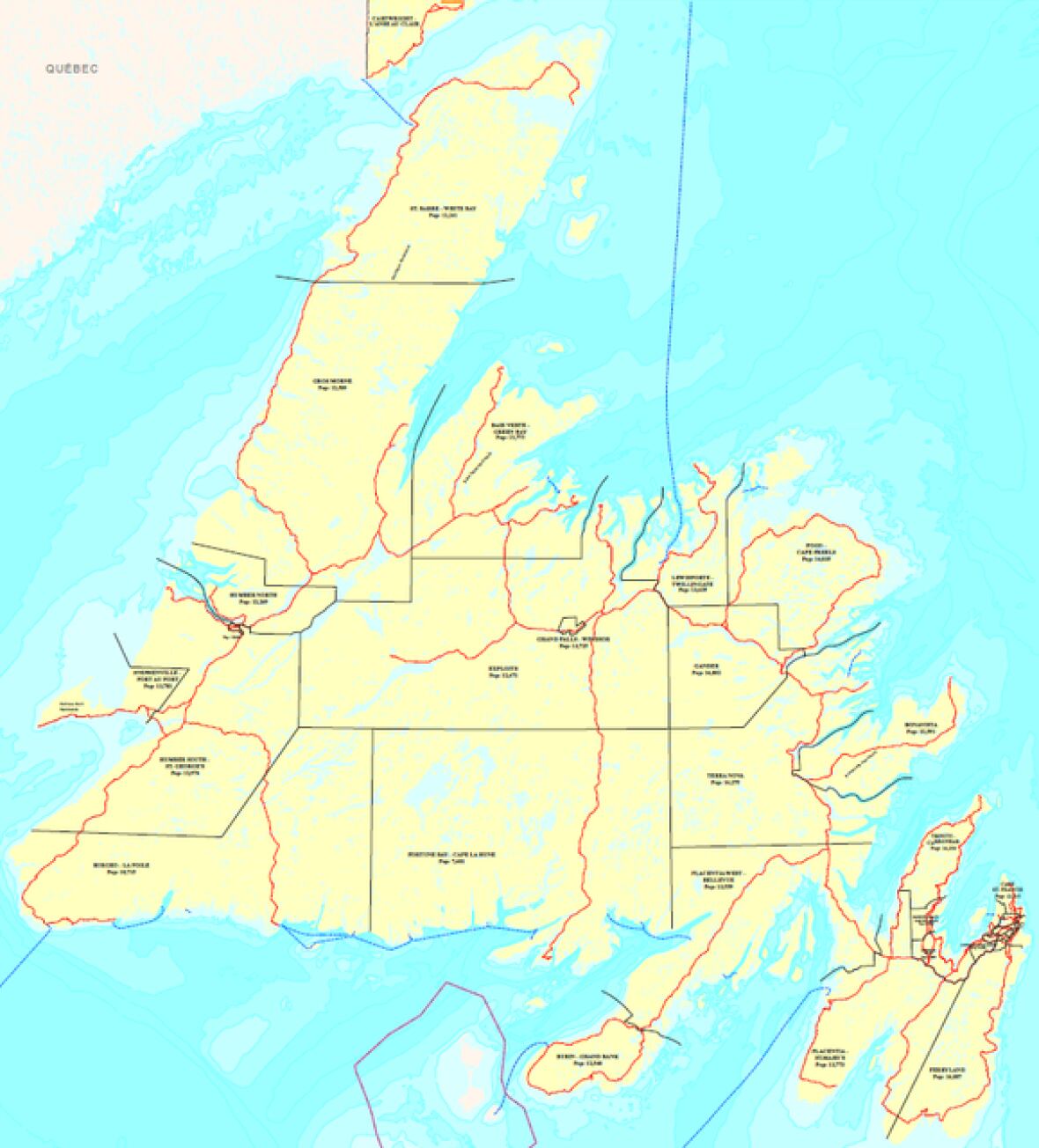Boundaries commission proposal targets rural Newfoundland
Series of 12 public hearings to begin April 22 in St. John's
The electoral boundaries commission has released a proposal for reducing the number of districts in Newfoundland and Labrador from 48 to 40.
The new map shows seven of the eight seats will be eliminated from rural areas outside of the Avalon Peninsula, where the greatest population drops have been recorded.
Labrador is maintaining its four districts.
The next step in the process will include a series of 12 public hearings, which will begin April 22 in St. John's.
NDP Leader Earle McCurdy, who does not have a seat in the legislature, criticized the report Friday, saying it unfairly slashes representation in rural areas at a time of great economic challenges and uncertainty.
"I think this was unnecessary. It was done with indecent haste. It imposed a major cutback in democratic representation for rural Newfoundland, and we don't need it at a time when an election is only a few months away," McCurdy said.
McCurdy was not surprised by the proposal, since the commission was following the guidelines set out under Bill 42.
Justice Minister Darin King, who is also the government house leader, refused to comment on the specifics of the report when he met with reporters Friday, saying he will speak more on the issue when the matter is debated in the House of Assembly.
King said he's encouraged by what the commission has been able to achieve in such a short period of time, and added, "I'm very confident they will met their timelines and we'll be able to pass the new legislation in time for the fall election."
The commission is chaired by Justice Robert Stack and was established in mid-February, after the Progressive Conservative government of Premier Paul Davis announced plans to reduce the size of the legislature as a cost-cutting measure.

Rural areas still over-represented
In an interview Friday about the process of identifying the proposed districts, Stack described the discussions as "collegial," and said there was "no difficulty" among commission members in reaching a consensus.
He said the reduction in seats in rural areas of the province is representative of the shift in population that has occurred over time.
In fact, he said rural areas would actually be over-represented in comparison to the Avalon Peninsula if the proposed boundaries are adopted.
He referred to this as "effective representation" in light of the fact there are fewer services and institutions in rural areas, making it "more difficult for members to service" these areas.
When it came to naming the districts, Stack said the commission tried to use historic names such as Ferryland, or well-known geographic features such as Gros Morne and Terra Nova.
A dramatic overhaul
The changes will dramatically overhaul the electoral system on the island portion of the province, and likely set the stage for some interesting nomination battles in the coming months.
For instance, changes on the west coast could result in a nomination battle in the new district of Gros Morne between Liberal Leader Dwight Ball, the MHA for Humber Valley, and Liberal MHA Jim Bennett (St. Barbe).
The new district of Trinity-Carbonear could also see two incumbent Liberals — Steve Crocker (Trinity-Bay de Verde) and Sam Slade (Carbonear-Harbour Grace) — battling it out for the nomination.
Things could also get complicated for the Tories in several districts where sitting MHAs may soon overlap, including Sandy Collins (Terra Nova) and Ross Wiseman (Trinity North), Derrick Dalley (The Isles of Notre Dame) and Eli Cross (Bonavista North), and Calvin Peach (Bellevue) and Clyde Jackman (Burin-Placentia West).
Meanwhile, following the public hearings, which conclude May 1 in Conception Bay South, Stack and his committee will present a final report to cabinet by early June.
If they miss that deadline, the election scheduled this fall will proceed with the current 48-seat legislature.
MHAs in Newfoundland and Labrador are among the highest paid politicians in Atlantic Canada.
As well, MHAs represents the fewest constituents in the country with an average of about 10,000 in each district.
Politicians of every stripe have supported a move towards fewer MHAs in recent years.
Proposed list of district names
Here is the list of districts proposed by the electoral boundaries commission, with the population of each.
- Baie Verte-Green Bay (13,773)
- Bonavista (12,591)
- Burgeo-LaPoile (10,715)
- Burin-Grand Bank (12,540)
- Cape St. Francis (13,215)
- Cartwright-L'Anse au Clair (3,845)
- Conception Bay South (14,563)
- Corner Brook (13,046)
- Exploits (12,471)
- Ferryland (14,007)
- Fogo-Cape Freels (14,035)
- Fortune Bay-Cape La Hune (7,401)
- Gander (14,802)
- Grand Falls-Windsor (13,725)
- Gros Morne (12,509)
- Harbour Grace-Port de Grave (14,838)
- Harbour Main (14,880)
- Humber North (12,269)
- Humber South-St. George's (12,974)
- Labrador West (9,238)
- Lake Melville (10,097)
- Lewisporte-Twillingate (13,439)
- Mount Pearl-Southlands (14,052)
- Mount Pearl North (14,142)
- Mount Scio (14,482)
- Pippy Park (14,187)
- Placentia-St. Mary's (13,773)
- Placentia West-Bellevue (13,559)
- Portugal Cove-Bell Island (14,885)
- St. Barbe-White Bay (12,241)
- St. John's Centre (14,354)
- St. John's East-Quidi Vidi (14,443)
- St. John's West (14,028)
- Stephenville-Port au Port (13,781)
- Terra Nova (14,275)
- Topsail-Paradise (14,830)
- Torngat Mountains (3,548)
- Trinity-Carbonear (14,230)
- Virginia Waters-Pleasantville (14,152)
- Waterford Valley (14,601)

